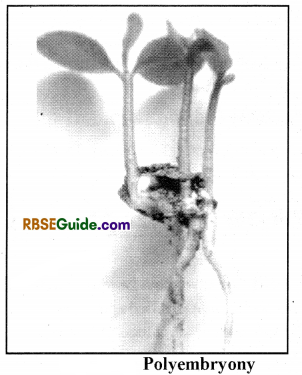Rajasthan Board RBSE Class 12 Biology Notes Chapter 4 Special Methods of Plant Reproduction
Generally reproduction in angiosperm plants is completed through vegetative or sexual method. Sometimes certain methods of reproduction are found, where plant develops without fertilization. These methods are known as special methods of plant reproduction. Some writers call them as asexual reproduction also. Special Methods of Plant
Reproduction are :
- Apomixis
- Agamospermy
- Micro-propagation
- Vegetative propagation
Apomixis
According to Hein’s Winkler (1908), substitution of usual sexual reproduction by a form of reproduction which does not involve meiosis and syngamy is called apomixis. According to some embryologists, vegetative propagation and agamospermy are also included under category of apomixis.
![]()
According to valid definition apomixis is generally of two types.
- Sporophytic apomixis : This is also called adventive embryony. In this apomixis, embryo is formed from nucellus or integument or any diploid cell of ovule. There is no meiosis and fertilization.
- Gametophytic apomixis: In this apomixis, embryo developes from any cell of embryo-sac.
It is of two types :
(i) When embryo developes from unfertilized egg then this process is known as parthenogenesis.
(ii) When embryo developes from any other haploid cell of embryo sac such as accessory cells or synergids, then this process is called as apogamy.
Prof. Panchanan Maheshwari (1950) divided apomixis in following types as Non recurrent apomixis and Recurrent apomixis. These are further divided into many types. We will study four types in brief.
- Non recurrent apomixis.
- Recurrent apomixis
- Adventive embryony
- Vegetative apomixis
Nonrecurrent Apomixis
Non-recurrent apomixis is where an embryo arises directly from a normal egg cell without the process of fertilization. Egg cells is haploid and hence, the resulting embryo is also haploid. Non-recurrent apomixis is called haploid parthenogenesis. This process was first of all studied by Jorgensen in 1928. If Embryo developes from any other cell of female gametophyte other than egg cell it is called haploid apogamy or androgamy. These types of apomixis are rare and are of genetic interest. This apomixis is found in Datura and Maize.
Recurrent Apomixis
This apomixis is also called gametophytic apomixis. As meiosis is not completed. So in this apomixis, female gametophyte has chromosome number diploid as of mother plant. It is of two types.
- Generative Aposopory : In this type of apomixis embryo sac developes from diploid cell of archesporium. Diploid cell of embryo sac forms diploid embryo.
- Somatic Apospory : In this apomixis, diploid cells of nucellus and integuments form diploid embryo sac and this diploid embryo sac forms diploid embryo.
Adventitive Embryony
In this process of embryo development, embryo developes from any diploid cell of ovule out side of embryo sac. Example : From nucellus or integumentry cells. This process is known as adventive embryony. In addition to adventive embryony process, regular embryo within the embryo sac may also develop simultaneously resulting in to poly-embryony condition. Example : Lemon, Mango, Opuntia
Vegetative Apomixis
In some plants like Poa bulbosa, some Allium, Agave and some grass species, vegetative buds (Bulbil and Propagules) are produced instead of flowers in the inflorescence. They germinate while on the plant itself. They can be reproduced without difficulty.
Importance of Apomixis :
- Apomixis does not involve meiosis, so that there is no segregation or recombination. Plants obtained through this process are exactly similar to the mother plant. It is an effective tool to produce clone.
- Apomixis results in -rapid multiplication of genetically similar individuals without risk of segregation.
- Heterosis or hybrid vigour can be maintained permanently in crop plants.
- There can be efficient exploitation of maternal effect from generation to generation.
- Homozygous inbred lines can be rapidly developed as they produce sectors of diploid tissues and occasional fertile gametes and seeds.
- This method is useful to produce hybrid seeds because it prevents loss of specific features in them.
![]()
Agamospermy
This is the pheonmenon of formation of embryos through reproductive process without the formation of gametes (by gametogenesis) and the act of fertilization : In this process the reproductive unit is seed only but this seed is not formed through normal sexual reproduction.
When seed is formed from any dipolid cell or by any abnormal cell of embryo sac without fertilization it is called agamospermy. This seed is also diploid but it contains all genes of mother plant. It may be of many types. One of it’s major type is adventive embrvony (already discussed in detail).
Micropropagation
Micropropogation is the technique of rapidly multiplying stock plant material to produce a large number of progeny plants, using modem plant tissue culture methods. We will study this technique in details in other unit. Micropropagation is used to multiply plants which have been genetically modified or bred through conventional plant breeding methods. It is also used to produce sufficient number of plantlets for planting from a stock plant which does not produce seeds or does not respond well to vegetaive reproduction.
Explant material such as stem tips, anthers, petals, pollen and other plant tissue is grown on culture medium under sterilized and controlled conditions. These cells and tissue produce callus or plantlets in vitro condition.
![]()
Differentiation of cells and development of root leads to development of plantlets . In the final steps of plant micropropagation, the plantlets are removed from the media and transferred to soil or (more commonly) potting compost for continued growth by conventional method. This method of plant reproduction is called micropropagation.
Advantages
- Production of many plants that are clones of each other.
- It can be used to produce disease-free plants.
- It has an extraordinarily high reproductive rate, producing thousands of propagules.
- Only viable method of regenerating gentically modified cells or cells after protoplast fusion.
- A greater number of plants can be produced per square metre and the propagules can be stored longer and in a smaller area.Example : Orchids, Gladiolus, Chrysanthemum
Polyembryony
Normally in plants, one seed contains only one embryo but sometimes more than one embryo develops in a single seed. Development of more than one embryo from ovule, seed or fertilized ovum is called polyembryony. Polyembryony is found in both plants and animals. In 1719.
Antony Von Leeuwenhoek first described polyembryony in Citrus fruit (Orange). It is a common feature in gymnosperms whereas it is found . only in few genera of angiosperms such as lemon, black berry, tobacco, Allium. Crotalaria etc. In most cases of polyembry ony one embryo only matures in one seed and other embryos are destroyed during embryo development. Some plants such as Vanda, which is an epiphyte, many mature embryos are found at the time of seed gennination.

Causes of Polyembryony in Angiosperms
Polyembryony is a general features of gymnosperm but it can ocuur in angiosperms due to following reasons :
- Cleavage in proembryo
- Development of any other cell of embryo sac along with egg cell.
- Development of more than one embryo sac is one ovule.
- Over activity of sporophytic cells of ovules.
Note—Polyembryony in plants is developed because of reasons stated above. Details of which can be understood as per following :
![]()
Cleavage Polyembryony
In this type of polyembryony, there is cleaveage of zygote or proembryo, which leads to development of more than one embryo. In Orchid, Eulophia, there are three types of cleavage polyembryony.
- Abnormal division in oospore results in formation of cellular mass, and cells towards chalazal end increase in number and form many embryo.
- There is formation of buds or outgrowth from proembryo and this leads to formation of many embryo.
- Filamentous Embryo : In this polyembryony branching occurs in proembryo and embryo developes from each branch.
Development of Embryo from cells of embryo sac other than the egg cell.
In this polyembryony, fertilized or unfertilized accessor}’ cells or synergids develop into embry o. They may be diploid if develop from fertilized (Aristolochia bracheata) and haploid (Argemone mexicana) if develop from unfertilized cells.
Development of more than one embryo sacs in the ovule
In some angiospermic plants such as Casuarina montana etc. more than one embryo sacs develope in ovule and each egg cell in each embryo sac after fertilization forms an embryo. In this w ay more than one embryo can develop in one ovule.
Adventive polyembryony
Sometimes cells of nucellus or integument get activated and form embry o. This type of developing embryo is called adventive embryo and process as adventive polyembryony.
Significance of Polyembryony :
Significance of polyembryony in horticulture, cell biology, genetics and plant-breeding are as follows :
- Adventive embryo developed from nucellus are exactly similar to mother plant.
- Plants produced from embryos developed from the cells of nucellus are full of vigour.
- Embryos developed from nucellus are disease free. For example : Virus free clone of lemons are produced by polyembiyony.
- Haploid embryo has its significance in cell biology.
- These haploid embryos can be treated with colchicine chemical to produce homozygous lines which has its importance in plant breeding experiment.
